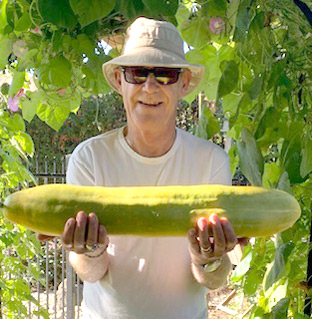HILLSBURGH – Hey first-time gardeners. Thinking about planting a vegetable garden this summer?
Gardening is forecast to be a hot activity this year as physical distancing measures are expected to remain in place for many weeks or even months and families are looking for something constructive to do with their time at home.
Add to that the uneasy feeling at the grocery store these days, and the challenges in buying locally-grown food, and a little backyard bounty may be sounding like a good idea. And for the price of a few seed packs, if you get even a few veggies to eat, it’s a delicious return on investment.
Conrad Wheildon, a member of the Hillsburgh Garden Club, has been growing vegetables in his garden for some 40 years, and he insists it’s not hard.
“The three most important things are good soil, good seeds, and good luck,” he said with a laugh.
He’s pretty passionate about growing vegetables and thinks it’s an important skill for children to learn. It teaches practical things like planting and watering and the care required for different plants, but there are also the larger lessons about patience, nurturing, the environment, food security and self-confidence.
“If I could show kids how to grow vegetables, I would do it every day of my life,” Wheildon said.
There’s plenty of information about gardening on the internet and through horticultural societies and master gardener organizations. Wheildon offered the following advice to get first-timers going:
Choose the site
It’s not necessary to till the entire backyard to have a garden but you do need to find a site that gets at least six hours of sunlight a day.
If you have the space, you can dig a small patch in the yard, or consider container gardening as a non-committal way to ease into gardening.
“I really like them,” Wheildon said of containers. “You can grow a variety of vegetables in a smaller space. And depending on what you plant, you can get two or three crops a season.”
Containers can be pretty much anything, from custom-built boxes to plastic garbage pails or even an old kitchen sink. As long as the container is deep enough for the vegetable being planted and there are drainage holes in the bottom, what you use is a matter of availability and personal taste.
Once you’ve chosen the site, fill the container or top up the garden with triple mix; water it and allow soil to settle before planting.
What to grow
Wheildon has a passion for growing giant varieties of vegetables and that requires both expertise and space. For first-timers, choose veggies you like and see how it goes, he said. Seeds are hard to find this year, so you might have to take what you can get.
Peas, radishes, carrots, and lettuce are all easy to grow from seed and can go in the ground now, Wheildon said. Potatoes and onions can go in the ground now too, he said.
“These plants are pretty frost-resistant and can go in early.
“But for most other seeds and seedling, wait until the soil temperature is at least 60 degrees F,” he said.
Watering
New gardeners tend to either over-water or under-water so getting it just right is critical. And you really do need to keep your eye on the weather, Wheildon said.
Veggies need a good, deep watering once or twice a week so if it’s been raining, leave the hose alone. If it’s been hot and dry, the garden might need a third weekly watering.
“I prefer to water first thing in the morning,” he said. “Watering at night can encourage bugs and mold.”
Ongoing maintenance
Once seeds start to sprout, thin them out so they are spaced according to directions on the seed pack. Some things need an inch of space between plants; others need a foot. This will allow the healthy plants to spread and grow and form produce of good size and shape.
Leave carrots bunched together and you get a network of twisted and oddly-shaped carrots.
Wheildon said if you start with good soil, it’s not necessary to add fertilizer or products like Miracle Grow.
You will need to weed the garden. Weeds can take water and nutrients and space from desirable plants.
Harvest
Harvest day is perhaps the greatest day of the growing season and the greatest crime is not eating the food the garden has produced.
“Don’t let your vegetables rot,” Wheildon said. “If it looks like you’re getting a bumper crop, do some planning. Freeze it, jar it, or put it in the root cellar.
“There’s nothing better that eating food fresh from the garden. But second best is eating food from the garden in the middle of winter.”




